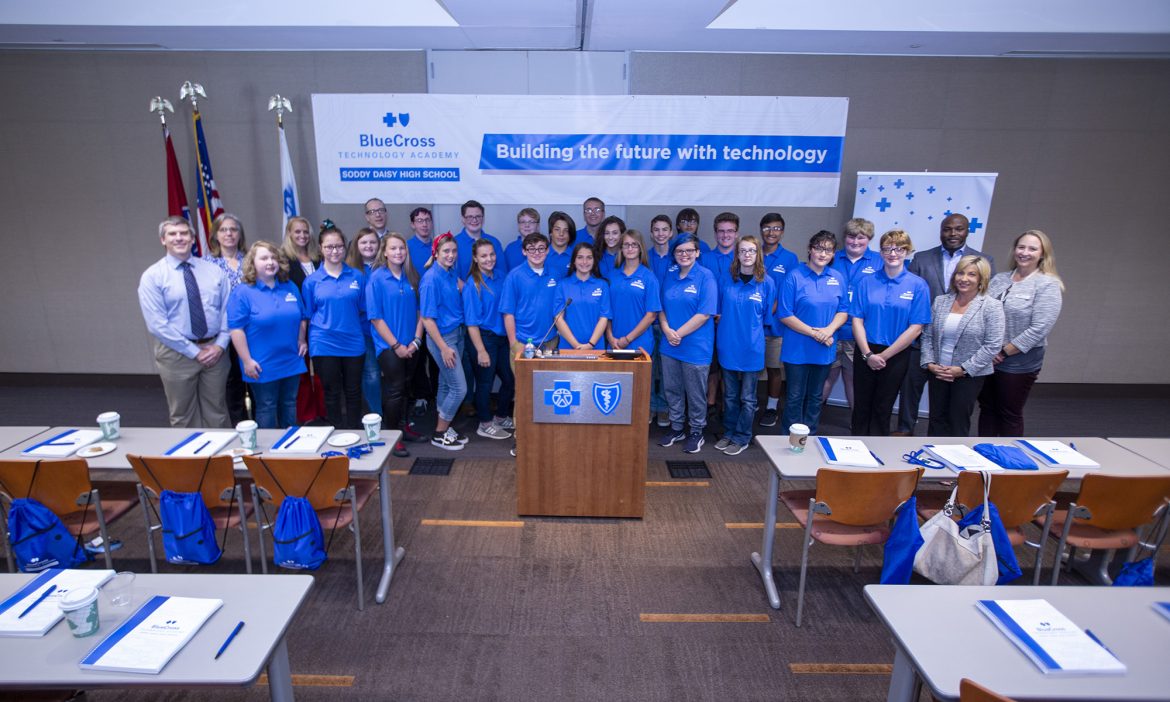The COVID-19 pandemic has affected everyday life across America and around the globe. Over the last three weeks, BlueCross has successfully shifted nearly all of its 6,700 employees across its six offices to working from home , and other companies have done the same.
“Our information services teams have worked closely with BlueCross business areas to ensure our employees have the equipment they need to effectively do their jobs from home,” says Jennifer Weaver, BlueCross vice president of infrastructure and operations. “We know we’re safer apart than together now, and I’m proud of the coordinated effort that has allowed us to keep operating our business and serve our members while doing our part to flatten the curve of COVID-19.”
Teachers are innovating and rising to the challenge, as well. Many have had to drop lesson plans and find alternative solutions to help their students study while staying at home.
In the Chattanooga area, schools are now closed through April 24. We spoke with Maureen Clark, a computer science teacher with the BlueCross Technology Academy at Soddy Daisy High School, about how she and her students are adapting, and thriving, despite the unexpected change.
Tell us about your class. What were you all studying when schools closed due to the spread of COVID-19?
Maureen: My class is the first-level course in the BlueCross Technology Academy. It’s computer science foundations, and it’s made up of ninth and tenth graders. We’re learning about networking and how the internet works, computer hardware, cybersecurity and a little bit of coding. It’s a general overview of technology.
I’m preparing my kids for the CompTIA IT Fundamentals exam. This is the first certification exam recommended for BlueCross Tech students. It puts them on the right path to having the IT knowledge and foundation they need when they go to college.

We covered all our material, and we were supposed to be reviewing for the next month and a half. I’m hoping the kids stay plugged in enough to review because I was planning to have them take the exam the first week of May.
My students are going to be reviewing for the test using resources like Quizlet, which is kind of like flashcards. They have all the terminology and definitions for the CompTIA exam. There are 340 terms and another 75 acronyms. Right now, they’re supposed to spend 30 minutes a day reviewing to keep the vocabulary fresh in their heads.
All the students in my BlueCross Tech class have internet access at home. I’m very fortunate in that respect. The school is open for them to come in and get materials, though, so if I needed to print off something or give them a packet with information, I could.
Because we’re a BlueCross Technology Academy, we have become a CompTIA testing center, and I’m getting some resources in the mail. There’s a practice exam, which also has an online version. I want to start giving the kids some of these exams to help them prepare.
Are you looking for other ways to connect and keep them engaged in that review process?
Maureen: Yes, I’m thinking of maybe doing a Zoom meeting with them, seeing if we can get them all online. Quizlet will also allow you to play live games while reviewing.
How are you and your students staying connected with one another while everyone is social distancing?
Maureen: In Hamilton County Schools, we have Canvas, which is a virtual classroom and learning platform that universities have. We also have Google Classroom. I use that for announcements because it automatically notifies the student. I can say, “Hey, go look here for this.”
Our school is rural, and there are some students that don’t have access to things at home. For some, school is the first time they’ve been exposed to the internet. I’ve sent out a survey to all of my kids – not just those in the BlueCross Tech class – to see which ones have Internet access and which ones don’t.
If I don’t get responses, I’ll start calling to check in with parents to make sure my students have what they need.
There’s also a social worker at the school. She let us know that if any of our kids need anything, she’s still there doing her job. To me, the first step is identifying the problem. Then from there, you come up with the solution. If they don’t have internet, why not? If they can’t get internet access, then we need to come up with another solution.
But the big thing is finding that safe option where they’re not going to the library or somewhere else. They’re staying put. We also want to find a solution where they’re not being penalized because they don’t have the advantages everyone else does. That’s kind of a fine line too, you know?
Are there any other events or activities in your class that have been delayed or canceled due to the outbreak?
Maureen: Yeah, so my students have been great because this is such a fluid thing. The University of Tennessee at Chattanooga has something called the Tech Symposium, when engineering students display their graduate capstone projects. Each year, they invite Hamilton County students to come out and observe. If the high school students build something, they’re also invited to show off their technology and what they’ve done.
There was a group of four students in my class working on a magic mirror project for the symposium. It was basically a mirror that someone could hang in their house, but in the top left corner, it displayed the weather. There was also a newsfeed that ran across it.
They used a two-way mirror like police departments have, and they built the system using a Raspberry Pi, which is a very basic computer with a small motherboard. They had to code and program the Raspberry Pi to make the mirror work.
They got it all working and were just getting ready to build the frame, then the symposium, which was scheduled for April 17, was canceled. Again, they have been so flexible and understanding. They were okay with not finishing the project because they wanted to spend the time preparing for their testing.
That’s too bad, but it’s wonderful that your students have been so understanding. Is there anything you’d like to share about your experience as a BlueCross Technology Academy so far?
Maureen: From a teacher’s perspective, I appreciate the community partnership meetings. Representatives from our school, BlueCross, some parents and some other IT community members get to meet and talk about the kids – if they’re going in the right direction and if we’re providing them with good opportunities. I know there’s stuff going on behind the scenes because BlueCross always comes with good questions and good ideas.
Students really enjoy the guest speakers that come into the classroom. We just had a visit from James Barksdale, a cyber threat analyst at BlueCross. Those are great because a teacher can tell a student something a hundred times, but until the professional comes in and says it, they don’t believe it. James connected all the dots and helped my students see how the certifications they’re working toward now can help them get internships later.
BlueCross is doing the right thing by these kids and by their programs. I’m happy to be a part of this and of giving these kids an opportunity. We all know opportunities are out there for them, but sometimes you have to get them to see that first.


 Amanda joined the BlueCross BlueShield of Tennessee corporate communications team in 2017. Born and raised in Chattanooga, she has a decade of experience in writing for print and the web, as well as digital marketing.
Amanda joined the BlueCross BlueShield of Tennessee corporate communications team in 2017. Born and raised in Chattanooga, she has a decade of experience in writing for print and the web, as well as digital marketing.